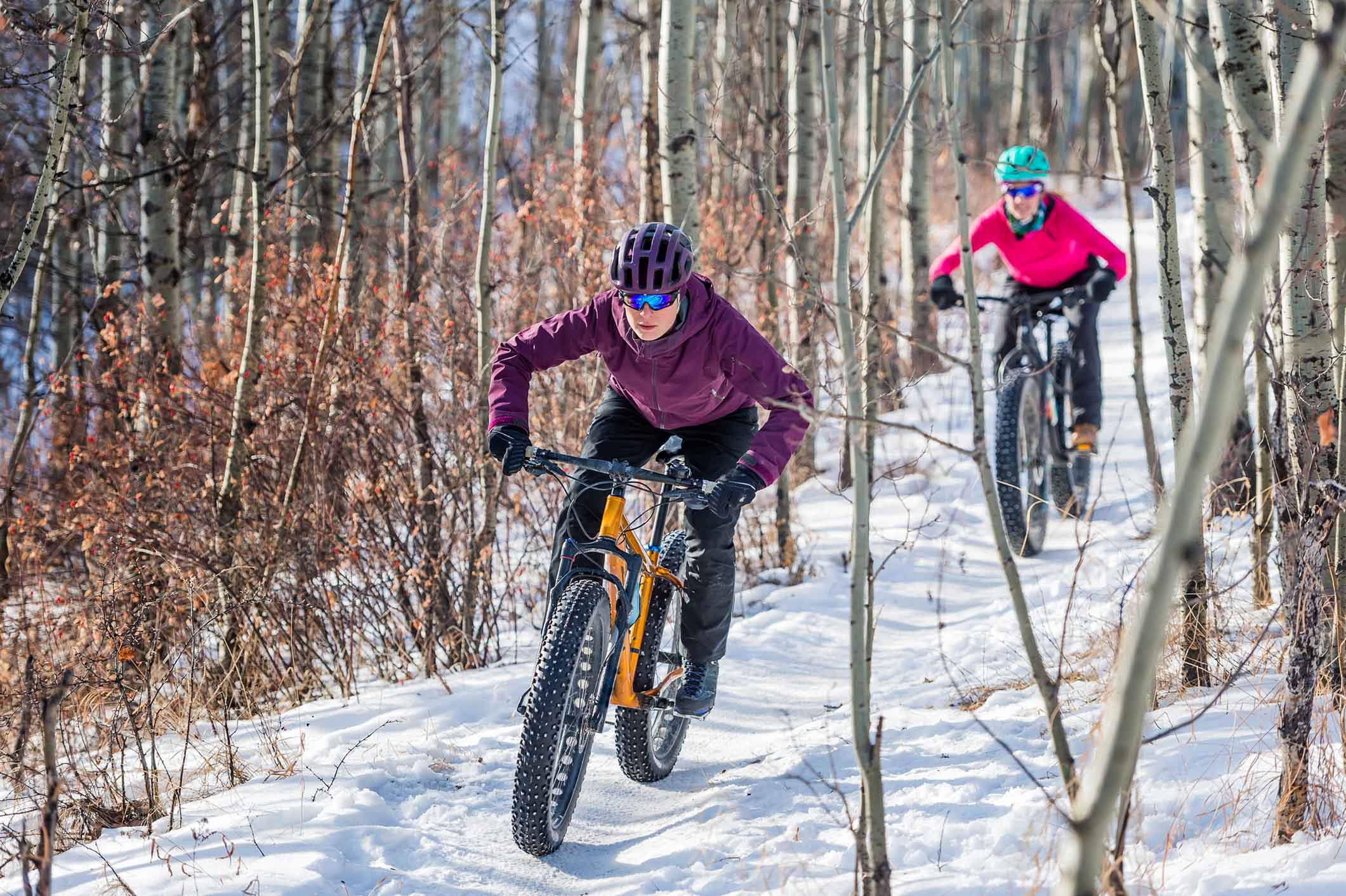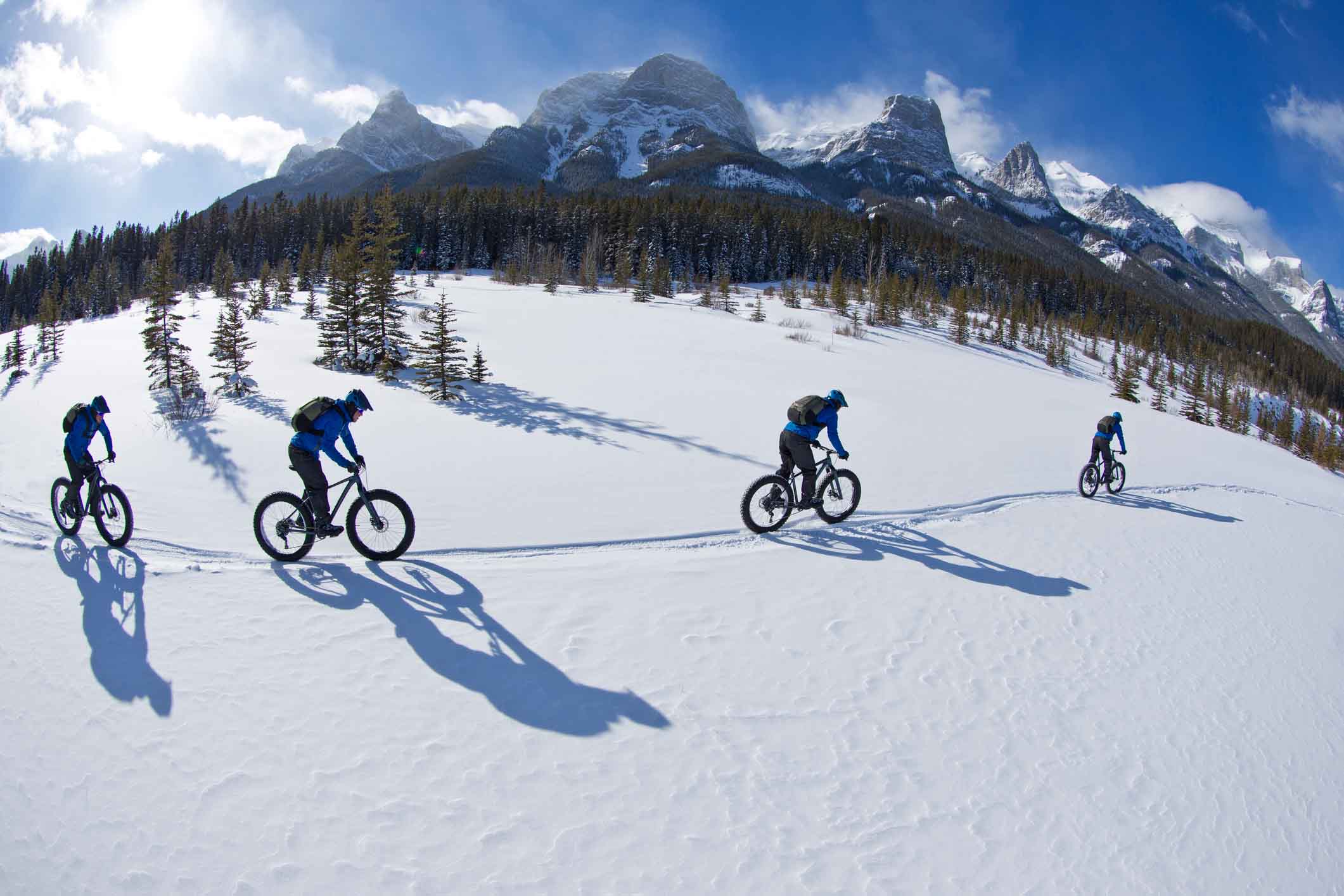Fat biking, a niche yet rapidly growing segment of the cycling world, has gained traction in the UK for its versatility and adaptability to challenging terrains, including snow-covered landscapes. It’s popular with cyclists seeking adventure and year-round riding opportunities, with the sport seeing a growing community of followers.
With the right equipment, attire, and knowledge, you can get involved and start to confidently navigate the sport that offers such a thrilling experience. Whether exploring fat biking hotspots within the UK or venturing abroad to iconic destinations, you’ll get to enjoy a unique perspective as you immerse yourself in the great outdoors like never before. Always prioritise safety, adhere to trail etiquette, and respect the environment to make the most of your fat biking adventures.
In this in-depth guide, we’ll delve into the world of fat biking, exploring its origins, key considerations, and the best places to go to participate in the sport.
What is fat biking?
Fat biking involves riding bicycles equipped with oversized tyres, typically 3.8 inches (97mm) or wider, which allow cyclists to traverse terrains that would be difficult or impossible for a standard mountain bike. The wider tyres, often run at lower pressures, increase the surface area in contact with the ground, providing enhanced stability and traction.

The history of fat biking
The history of fat biking can be traced back to the early 1980s in Alaska, when cyclists sought a way to continue riding during the winter months as traditional bikes struggled in the snow. The development of fat bikes was a response to the unique challenges posed by soft, snowy terrain and the desire to explore off-road trails year-round.
From its humble beginnings to its global recognition today, fat biking has evolved into a distinct cycling discipline. With a rich history of innovation, collaboration, and community building, it continues to capture the imagination of cyclists seeking year-round adventure on two wheels. Its history is a testament to the cycling community’s ingenuity and determination to overcome the challenges posed by winter conditions.
Origins and early innovations
The birth of fat biking is often associated with the Iditabike, a race that followed part of the Iditarod Trail in Alaska. In 1987, cyclists modified their bikes by widening the forks and using oversized tyres to navigate the snowy conditions. These rudimentary adaptations laid the groundwork for the development of purpose-built fat bikes.
In 1989, Ray Molina, a New Mexico-based cyclist, took the concept a step further by designing the first purpose-built fat bike. Molina’s creation, the Surly Pugsley, featured a frame with wider clearances and large 3.8-inch tyres, providing enhanced floatation on soft surfaces. The Pugsley became the archetype for fat bikes and set the stage for the commercialisation of this niche cycling category.
Commercialisation and popularisation
As the Pugsley’s success inspired other manufacturers to explore the fat bike market, and interest in the sport grew, creators began refining designs and experimenting with components. Fat bikes evolved to include suspension systems, improved gearing, and lightweight materials, enhancing their performance and appeal to a broader audience.
While fat biking originated in snowy regions, its popularity transcended geographic boundaries. Global enthusiasts recognised the versatility of fat bikes, leading to increased demand in areas with diverse terrains, including deserts, beaches, and muddy trails.
Recognition in the cycling community
The establishment of fat bike championships and events further solidified the category’s presence in the cycling community. Races like the Iditarod Trail Invitational and the Fat Bike Birkie in Wisconsin became showcases for fat biking prowess, attracting participants from around the world.
The cycling industry responded to the growing popularity of fat biking by collaborating on standards for components, such as tyre and rim sizes. This standardisation facilitated the production of interchangeable parts, contributing to the accessibility and affordability of fat bikes.
Rise in popularity
The advent of social media platforms and online communities played a crucial role in fostering a sense of camaraderie among fat bike enthusiasts. Shared experiences, trail recommendations, and group rides contributed to the sense of community surrounding fat biking.
Increased media coverage, including feature articles, documentaries, and online content, showcased the unique experiences offered by fat biking. This exposure helped demystify the sport and encouraged more cyclists to explore the world of fat biking.

The key elements of fat biking
Here are the key things to know about fat biking and how it works.
Terrain
Fat bikes excel on various terrains, including snow, sand, mud, and rocky trails. Their wide tyres provide stability and traction, making them ideal for off-road adventures in challenging conditions.
Tyre pressure
Adjusting tyre pressure is a crucial consideration for fat biking. Lowering the pressure increases the tyre’s footprint, enhancing grip and floatation on soft surfaces like snow. Experimenting with tyre pressure allows riders to fine-tune performance based on terrain and personal preference.
Frame material
Aluminium and carbon fibre are common materials for fat bike frames. Aluminium is durable and more budget-friendly, while carbon fibre offers a lighter option for those wanting more manoeuvrability.
Gearing
Fat bikes often feature a wide range of gears to accommodate different terrains. Choosing a bike with appropriate gearing ensures optimal performance in a variety of conditions.
Braking system
Disc brakes are standard on fat bikes, providing reliable stopping power even in adverse weather conditions. Hydraulic disc brakes offer superior performance and are preferable for winter riding.
Clothing
Weather conditions can be unpredictable for fat biking in the UK, so selecting the right clothing is crucial. Layering is key, with a moisture-wicking base layer to manage sweat, an insulating layer for warmth, and a waterproof and windproof outer layer to shield against the elements. Waterproof, breathable gloves, thermal socks, and durable cycling shoes are essential for maintaining comfort during extended rides.
Why is fat biking becoming more popular in the UK?
Besides its adventurous appeal, there are several reasons more and more people are taking up this sport.
Versatility
Fat bikes’ adaptability to diverse terrains makes them a versatile choice for cyclists seeking adventure beyond traditional trails. The UK’s varied landscapes, from snowy peaks to muddy trails, make fat biking an appealing option for exploration.
All-seasons riding
Unlike some cycling disciplines limited by weather conditions, fat biking enables enthusiasts to ride throughout the year. The ability to tackle snow-covered paths extends the cycling season, for a unique and challenging experience.
Social connection
The growing number of fat bikers in the UK means you can enjoy a pleasant sense of community with other bikers. Group rides and events contribute to the sport’s popularity, creating opportunities for like-minded people to share experiences and explore new routes together.
Can you ride a fat bike in the snow?
Yes, fat bikes are specifically designed for snow riding. Their wide tyres and lower pressure allow them to float on top of the snow, providing traction and stability.
Is a fat bike better than a mountain bike in snow?
Fat bikes outperform traditional mountain bikes in snowy conditions due to their wider tyres, which prevent them from sinking into the snow. The increased surface area enhances stability and grip on soft surfaces.
Are fat bikes better than plus bikes in snow?
While both fat bikes and plus bikes (with slightly wider tyres than standard mountain bikes) can handle snow, fat bikes are generally more effective. The extra width of fat bike tyres provides better flotation and traction in deep snow.
Are fat bikes good for winter?
Fat bikes are well-suited for winter riding, offering a unique and enjoyable experience in snow-covered landscapes. Their adaptability to various winter conditions makes them a popular choice for cyclists looking to extend their riding season.

Best places for fat biking in the UK
Here are some of the most popular places to go fat biking in the UK.
Cairngorms National Park, Scotland
The Scottish Highlands, particularly Cairngorms National Park, provide breathtaking scenery and a variety of trails suitable for fat biking. The snow-covered landscapes during winter offer a challenging yet rewarding experience for enthusiasts.
Lake District, England
The Lake District boasts a mix of rugged trails, forested paths, and scenic routes. Cyclists can explore the picturesque surroundings, encountering challenging terrains that make for an exciting fat biking adventure.
Brecon Beacons, Wales
The Brecon Beacons National Park in Wales offers a diverse range of trails, from mountainous terrains to forestry tracks. Fat bikers can enjoy the stunning landscapes while tackling both challenging and more leisurely routes.
Swinley Forest, England
Located in Berkshire, Swinley Forest is known for its well-maintained trails suitable for fat biking. The forest offers a mix of singletracks and wider paths, providing options for riders of varying skill levels.
North Pennines, England
The North Pennines, designated an Area of Outstanding Natural Beauty (AONB), features trails that wind through valleys and open moorlands. Fat bikers can explore this less crowded but equally stunning region.
The best places for fat biking abroad
If you want to venture further afield and see what the rest of the world has to offer, these destinations are a safe bet for enjoying the sport.
Whistler, Canada
Whistler, a renowned mountain biking destination, transforms into a winter wonderland during the snowy season. Fat bikers can explore the extensive trail network amid the picturesque Canadian Rockies.
Levi and Rovaniemi, Finland
Finland, with its vast snowy landscapes, offers excellent opportunities for winter fat biking. Destinations like Levi and Rovaniemi provide well-groomed trails through enchanting winter scenery.
Colorado, USA
The Rocky Mountains in Colorado provide a playground for fat bikers. Winter Park and Crested Butte are popular destinations with groomed trails, stunning vistas, and a variety of terrain.
Swiss Alps, Switzerland
Switzerland’s Alpine landscapes offer fat bikers a mix of challenging mountain trails and scenic routes. Engadin St. Moritz is one of the regions known for its winter fat biking experiences.
Iceland
With its otherworldly landscapes, Iceland is a captivating destination for fat biking. The volcanic terrain, glaciers, and unique geological features create a surreal backdrop for adventurous cyclists.
What to know when fat biking abroad
Here are some of the things you’ll need to think about before booking a trip:
Local regulations – Before embarking on a fat biking adventure abroad, educate yourself on local regulations and trail access policies.
Climate and weather – Research the climate of your chosen destination and prepare accordingly. Extreme temperatures or unexpected weather conditions can impact the riding experience.
Trail maintenance – Check if the trails are regularly maintained, especially in snowy destinations. Groomed trails provide a smoother and more enjoyable fat biking experience.
Guided tours and services – Consider joining guided fat biking tours or using local services that cater to fat bikers. This can enhance the overall experience and ensure access to the best trails.
Get winter sports travel insurance with SportsCover Direct
There’s nothing like getting out into the big wide world on your bike and enjoying the freedom of a completely exhilarating experience. Having the right insurance in place will help to further enhance your enjoyment of this high-risk sport.
SportsCover Direct’s winter sports travel insurance offers three different policy options. If you’ll be going overseas, our travel insurance is designed for over 500 sports, with cover for medical costs, trip cancellation and more. You can also opt for a bolt-on style of insurance if you already have a policy with another provider. If you’ll be doing winter sports in the UK, our sports accident insurance offers personal liability and income protection.
Find out more and get a quote today.
This blog has been created as general information and should not be taken as advice. Make sure you have the correct level of insurance for your requirements and always review policy documentation.